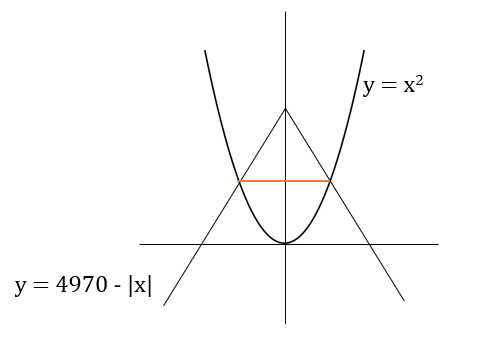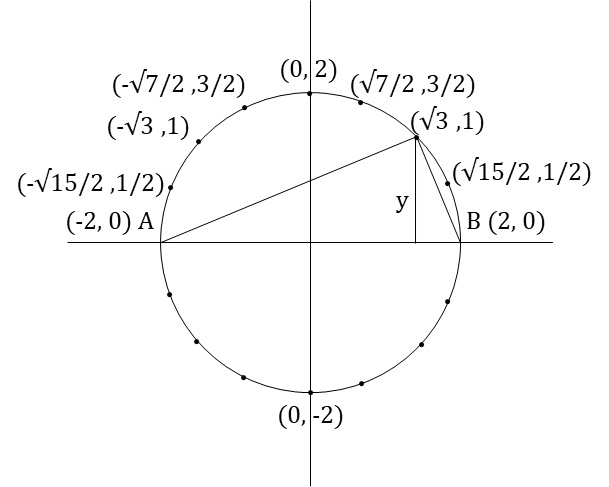IPMAT (I) 2023 QASA | Previous Year IPMAT - Indore Paper
In a chess tournament, there are four groups, each containing an equal number of players. Each player plays
- against every other player belonging to one's own group exactly once;
- against each player belonging to one of the remaining three groups exactly twice;
- against each player belonging to one of the remaining two groups exactly three times; and
- against each player belonging to the remaining group exactly four times.
If there are more than 1000 matches being played in the tournament, the minimum possible number of players in each group is .
Answer: 8
Explanation :
Let there be n players in each of these 4 groups.
∴ There are total 4n players.
Let the groups be called G1, G2, G3 & G4.
Now, a player from G1, say A, plays with other (n - 1) players from G1 exactly once.
Hence, he plays (n -1) games.
A will play with each of n players of G2 twice, hence total 2n games.
A will play with each of n players of G3 thrice, hence total 3n games.
A will play with each of n players of G4 four times, hence total 4n games.
∴ A will play a total of (n - 1) + 2n + 3n + 4n = 10n - 1 games.
Now, each of the 4n players will play (10n - 1) games.
∴ There will be total 4n × (10n - 1)/2 games [/2 because each game is counted twice]
⇒ There are total 2n(10n - 1) games
⇒ 2n(10n - 1) > 1000
⇒ n(10n - 1) > 500
The least possible value of n satisfying the above inequality is 8.
Hence, 8.
Workspace:
The remainder when 1! + 2! + 3! +.... + 95! is divided by 15 is.
Answer: 3
Explanation :
Here, factorials of number 5 and above are always divisible by 15, hence we can ignore them.
So the question simplifies to finding remainder of 1! + 2! + 3! + 4! when divided by 15.
= Remainder of (1 + 2 + 6 + 24) / 15
= Remainder of (33) / 15
= 3
Hence, 3.
Workspace:
Amisha can complete a particular task In twenty days. After working for four days she fell sick for four days and resumed the work on the ninth day but with half of her original work rate. She completed the task in another twelve days with the help of a co-worker who joined her from the ninth day. The number of days required for the co-worker to complete the task alone would be.
Answer: 24
Explanation :
Let the efficiency of Amish be 2 units/day.
If she can do the entire work in 20 days.
⇒ Total work to be done = 2 × 20 = 40 units.
Now, she works with full efficiency for first 4 days and with half efficiency for another 12 days.
∴ Work done by Amisha = 2 × 4 + 1 × 12 = 20 units.
⇒ Amisha's co-worker completed the remaining (40 - 20 =) 20 units of work in the last 12 days.
Hence, to complete the entire 40 units of work the co-worker will take 24 days.
Hence, 24.
Workspace:
The length of the line segment joining the two intersection points of the curves y = 4970 - lxl and y = x2 is
Answer: 140
Explanation :

y = 4970 - |x| & y = x2
To find intersection point we equate both equations.
⇒ 4970 - |x| = x2
⇒ x2 + |x| - 4970 = 0
⇒ |x|2 + |x| - 4970 = 0 [x2 = |x|2]
⇒ |x|2 + 71|x| - 70|x| - 4970 = 0
⇒ (|x| + 71)(|x| - 70) = 0
⇒ |x| = - 71 or 70 [- 71 rejeceted as |x| cannot be negative]
⇒ x = + 70 or - 70
∴ Line joining the intersection point of these graphs will be a horizontal line. The x coordinates of its end points are +70 & -70.
∴ Distance between the two points = 70 + 70 = 140.
Hence, 140.
Workspace:
If f(1) = 1 and f(n) = 3n - f(n - 1) for all integer n > 1, then the value of f(2023) is
Answer: 3034
Explanation :
Given, f(1) = 1, f(n) = 3n - f(n - 1)
Substituting,
n = 2, f(2) = 3 × 2 - f(1) = 5
n = 3, f(3) = 3 × 3 - f(2) = 4
n = 4, f(4) = 3 × 4 - f(3) = 8
n = 5, f(5) = 3 × 5 - f(4) = 7
n = 6, f(6) = 3 × 6 - f(5) = 11
n = 7, f(7) = 3 × 7 - f(6) = 10
Here, f(1), f(3), f(5), and so on, i.e., f(odd number) form an arithmetic progression with common difference of 3.
We need to find f(2023). Now, how many odd numbers are there from 1 till 2023 = (2023 + 1)/2 = 1012
∴ f(2023) = f(1) + (1012- 1) × 3
⇒ f(2023) = 1 + 1011 × 3 = 3034
Hence, 3034.
Workspace:
The product of the roots of the equation - 5log2 x + 6 = 0
Answer: 32
Explanation :
Here, let log2x = a
The given equation can be written as:
a2 × log22 - 5a + 6 = 0
⇒ a2 - 5a + 6 = 0 [log22 = 1]
⇒ a2 - 3a - 2a + 6 = 0
⇒ a(a - 3) - 2(a - 3) = 0
⇒ (a - 3)(a - 2) = 0
⇒ a = 2 or 3
⇒ log2x = 2 or log2x = 3
⇒ x = 22 or x = 23
⇒ x = 4 or x = 8
∴ Required product of the roots = 4 × 8 = 32
Hence, 32.
Workspace:
Assume it is the beginning of the year today. Ankita will earn INR 10,000 at the end of the year which she plans to invest in a bank deposit immediately at a fixed simple interest of 0.5% per annum. Her yearly income will increase by INR 10,000 every year and the fixed simple interest offered by the bank on new deposits will also increase by 0.5% per annum every year. If Ankita continues to invest all her yearly income in new bank deposits at the end of each year. the total interest earned by her in INR for five years from today will be?
Answer: 2500
Explanation :
Ankita earns Rs. 10,000 at the end of year 1 which is invested at 0.5% for 4 years.
∴ Interest earned = 10,000 × 0.5% × 4 = 200
Ankita earns Rs. 20,000 at the end of year 2 which is invested at 1% for 3 years.
∴ Interest earned = 20,000 × 1% × 3 = 600
Ankita earns Rs. 30,000 at the end of year 1 which is invested at 1.5% for 2 years.
∴ Interest earned = 30,000 × 1.5% × 2 = 900
Ankita earns Rs. 40,000 at the end of year 1 which is invested at 2% for 1 years.
∴ Interest earned = 40,000 × 2% × 1 = 800
∴ Total interest earned = 200 + 600 + 900 + 800 = 2500
Hence, 2500.
Workspace:
The polynomial 4x10 - x9 + 3x8 – 5x7 + cx6 + 2x5 – x4 + x3 – 4x2 + 6x – 2 when divided by x – 1 leaves a remainder 2. Then the value of c + 6 is
Answer: 5
Explanation :
Concept: Remainder of f(x) when divided by x - a is f(a).
Here f(x) = 4x10 - x9 + 3x8 – 5x7 + cx6 + 2x5 – x4 + x3 – 4x2 + 6x – 2
It has to be divided by x - 1.
∴ Remainder will be f(1)
⇒ f(1) = 4 × 110 - 19 + 3 × 18 – 5 × 17 + c × 16 + 2 × 15 – 14 + 13 – 4 × 12 + 6 × 1 – 2 = 2
⇒ 4 - 1 + 3 – 5 + c + 2 – 1 + 1 – 4 + 6 – 2 = 2
⇒ c + 3 = 2
⇒ c = - 1
∴ c + 6 = -1 + 6 = 5
Hence, 5.
Workspace:
In an election with only two contesting candidates, 15% of the voters did not turn up to vote, and 50 voters cast invalid votes. It is known that 44% of all the voters in the voting list voted for the winner. lf the winner got 200 votes mote than the other candidate, then the number of voters in the voting list is
Answer: 5000
Explanation :
Let the total number of voters in the list be 100x.
Total voters who voted is 85% = 85x
Invalid votes = 50
∴ Valid votes = 85x - 50
Winner gets 44% of total votes = 44x
∴ Second candidates gets = 85x - 50 - 44x = 41x - 50 votes
Given in the question
44x - (41x - 50) = 200
⇒ 3x + 50 = 250
⇒ 3x = 150
⇒ x = 50
∴ Number of voters in the voting list = 100x = 5000.
Hence, 5000.
Workspace:
If f(n) = 1 + 2 + 3 + ... + (n + 1) and g(n) = , then the least value of n for which g(n) exceeds the value of is
Answer: 199
Explanation :
Given, f(n) = 1 + 2 + 3 + ... + (n+1) =
Now,
= + + + ... +
= + + + ... + +
=
=
=
=
=
Now, this should be greater than 99/100
⇒ >
⇒ 100n > 99n +198
⇒ n > 198
∴ Least possible integer value of n = 199.
Hence, 199.
Workspace:
Vinita drives a car which has four gears. The speed of the car in the fourth gear is five times its speed in the first gear. The car takes twice the time to travel a certain distance in the second gear as compared to the third gear. In a 100 km journey, if Vinita travels equal distances in each of the gears, she takes 585 minutes to complete the journey. Instead, if the distances covered in the first, second, third, and fourth gears are 4 km, 4 km, 32 km, and 60 km, respectively, then the total time taken, in minutes, to complete the journey, will be______.
Answer: 312
Explanation :
The speed of the car in the fourth gear is five times its speed in the first gear
⇒ Let the speed in 1st gear be x kmph, hence speed in 4th gear will be 5x kmph.
The car takes twice the time to travel a certain distance in the second gear as compared to the third gear
⇒ Speed in 3rd gear is twice the speed in 2nd gear.
⇒ Let speeds in 2nd and 3rd gears be y & 2y kmph.
In a 100 km journey, if Vinita travels equal distances in each of the gears, she takes 585 minutes
⇒ 25/x + 25/5x + 25/y + 25/2y = 585/60
⇒ 25/x + 5/x + 50/2y + 25/2y = 39/4
⇒ 30/x + 75/2y = 39/4
⇒ 60/x + 75/y = 39/2
⇒ 20/x + 25/y = 13/2
⇒ 5(4/x + 5/y) = 13/2
⇒ 4/x + 5/y = 13/10 ...(1)
Now, we need to find the time taken if Vinita travels 4, 4, 32, 60 kms at 1st, 2nd, 3rd & 4th gear respectively.
⇒ 4/x + 4/y + 32/2y + 60/5x
= 4/x + 4/y + 16/y + 12/x
= 16/x + 20/y
= 4(4/x + 5/y)
= 4 × 13/10
= 5.2 hours
= 5.2 × 60 minutes
= 312 minutes
Hence, 312.
Workspace:
The total number of positive integer solutions of 21 < a + b + c < 25 is
Answer: 1160
Explanation :
We know number of ways of distributing n identical objects among r different groups such that each groups gets at least one object is n-1Cr-1.
Now,
Case 1: a + b + c = 21.
∴ We need to distribute 21 among 3 different variables a, b & c.
Number of ways of doing this = 21-1C3-1 = 20C2 = 190
Case 2: a + b + c = 22.
Number of ways of doing this = 22-1C3-1 = 21C2 = 210
Case 3: a + b + c = 23.
Number of ways of doing this = 23-1C3-1 = 22C2 = 231
Case 4: a + b + c = 24.
Number of ways of doing this = 24-1C3-1 = 23C2 = 253
Case 5: a + b + c = 25.
Number of ways of doing this = 25-1C3-1 = 24C2 = 276
∴ Total number of ways = 190 + 210 + 231 + 253 + 276 = 1160
Hence, 1160.
Workspace:
Let a, b, c, d be positive integers such that a + b + c + d = 2023. If a : b = 2 : 5 and c: d = 5 : 2, then the maximum possible value of a + c is
Answer: 1442
Explanation :
Given, a : b = 2 : 5 and c: d = 5 : 2
⇒ a = 2x, b = 5x, c = 5y and d = 2y
Also, a + b + c + d = 2023
⇒ 2x + 5x + 5y + 2y = 2023
⇒ 7x + 7y = 2023
⇒ x + y = 289
Now, we need to maximise a + c = 2x + 5y = 2(x + y) + 3y = 2 × 289 + 3y.
This can be maximised by maximising y (higher coefficient).
Since x & y have to be natural numbers, least value of x has to be 1, hence maximum value of y will be 288.
⇒ Maximum value of a + c = 2 × 1 + 5 × 288 = 2 + 1440 = 1442
Hence, 1442.
Workspace:
In the xy-plane let A = (-2,0), B = (2,0). Define the set S as the collection of all points C on the circle x2 + y2 = 4 such that the area of the triangle ABC is an integer. The number of points in the set S is
Answer: 14
Explanation :

AB = 4
Based on the figure, area of triangel ABC = 1/2 × AB × |y| = 2|y|
∴ 2|y| must be an integer.
Hence, y can be
Case 1: y = ± 1/2
⇒ x2 + (1/2)2 = 4
⇒ x2 = 15/4
⇒ x = ± √15/2
∴ 4 points i.e, (√15/2 ,1/2), (-√15/2 ,1/2), (√15/2 ,-1/2) & (-√15/2 ,-1/2)
Case 2: y = ± 1
⇒ x2 + (1)2 = 4
⇒ x2 = 3
⇒ x = ± √3
∴ 4 points i.e, (√3 ,1), (-√3 ,1), (√3 ,-1) & (-√3 ,-1)
Case 1: y = ± 3/2
⇒ x2 + (3/2)2 = 4
⇒ x2 = 7/4
⇒ x = ± √7/2
∴ 4 points i.e, (√7/2 ,3/2), (-√7/2 ,3/2), (√7/2 ,-3/2) & (-√7/2 ,-3/2)
Case 1: y = ± 2
⇒ x2 + (2)2 = 4
⇒ x2 = 0
⇒ x = 0
∴ 2 points i.e, (0 ,2) & (0 ,-2)
∴ Total 4 + 4 + 4 + 2 = 14 points
Hence, 14.
Workspace:
If three consecutive coefficients in the expansion of (x + y)n are in the ratio 1 : 9 : 63, then the value of n is
Answer: 39
Explanation :
We know (x + y)n = nC0 × xn + nC1 × xn-1 × y1 + nC2 × xn-2 × y2 + ... + nCn × yn
Let the three consecutive coefficients be nCr-1, nCr & nCr+1
Now, nCr-1 : nCr = 1 : 9
⇒ : = 1 : 9
⇒ =
⇒ 9r = n - r + 1
⇒ 10r = n + 1 ...(1)
Also, nCr : nCr+1 = 9 : 63 = 1 : 7
⇒ : = 1 : 7
⇒ =
⇒ 7r + 7 = n - r
⇒ 8r = n - 7 ...(2)
Solving (1) & (2), we get
n = 39 & r = 4
Hence, 39.
Workspace:
 Solution
Solution Discuss
Discuss Report
Report